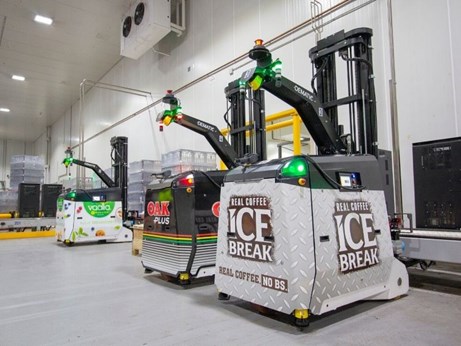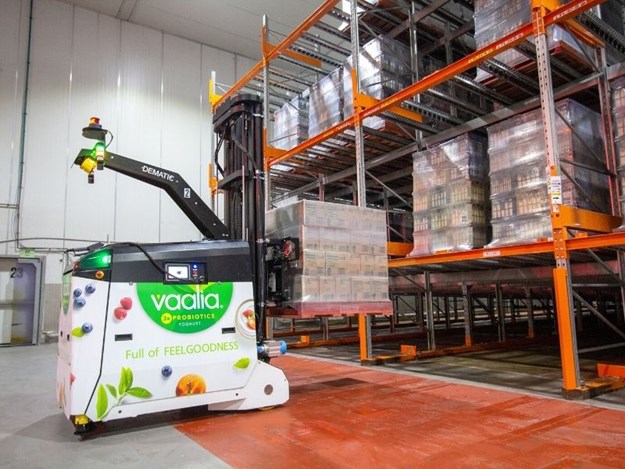Dairy processor Lactalis Australia has seen a boost in productivity following the installation of an automated guided vehicle solution at its Lidcombe milk site in Sydney
 |
|
Three of the four AGVs installed at Lactalis’ Lidcombe milk site in Sydney
|
Dematic, a leading global supplier of integrated automated technology, software and services to optimise the supply chain, has helped Lactalis Australia embrace technology to future-proof the third-generation family-owned business.
Four automated guided vehicles (AGVs) have been put in place in March 2019, running a faster operation 24 hours a day, seven days a week.
The vehicles have replaced forklift drivers in what’s described as a “tedious” working environment. The AGVs operate in the same area; a small working space, transporting pallets of milk in a chilled setting. They retrieve pallets from inbound conveyor system from production and feed them into order buffer lanes in gravity racking.
The system has reduced the manual pallet handling of repetitive tasks in a cold environment, improving safety and increasing accuracy, Lactalis national logistics optimisation manager Kristian Brennan says.
With eyes set on investing and growing the Australian dairy industry, Lactalis is looking for new ways to improve its operation by boosting efficiencies and productivity, he adds.
“The new AGV solution has successfully helped us to significantly increase productivity at our Lidcombe site as it allows us to run a faster operation 24 hours a day, seven days a week,” Brennan says.
The AGV solution chosen by Lactalis, Dematic’s Counterbalance Series AGV, manages the transportation of pallets of milk and is capable of lifting loads of up to 1.2 tonnes to a height of six metres.
“The AGVs are well-suited to working at the site, which is a chilled environment that has a temperature of two to four degrees Celcius,” Brennan says.
Operating in a small space, they manage tight traffic at high speeds of up to 1.7 metres per second.
The AGV solution’s accuracy and safety around workers and any obstacles is ensured through sensors and laser scanners that help them navigate with precision.
The AGVs are powered by Lithium Ion batteries and can drive themselves onto charging floor platers at times of inactivity and be fully charged in two hours, Dematic AGVs general manager Tony Raggio says.
“The need to optimise productivity and reduce costs in food and beverage supply chains has never been greater,” Raggio says.
“We’re excited to see Lactalis Australia has increased its productivity, while also being able to receive a good return on investment from it is investment in Dematic AGVs.”
 |
|
The system has reduced the manual pallet handling of repetitive tasks in a cold environment, improving safety and increasing accuracy
|
A manufacturer and supplier of AGVs globally, Dematic manufactures vehicles for the Asia Pacific region at its Sydney facility, providing a fully-integrated automation solutions for every application.
Used in a variety of industries to transport and store all kinds of products and materials without human interaction, AGVs are a safe and secure way to increase process efficiency and improve business profitability, Raggio says.
They automatically lift, rotate and shift goods, and fetch and carry loads to and from racking. They also store and retrieve in block-stack or deep-stack lanes up to 10.7 metres high, transport loads over long distances and can deliver and collect loads to and from a wide range of conveyors, processing machines, palletising systems and automated storage and retrieval systems.
Thanks to their accuracy and safety features, AGVs create a safer working environment, with no accidental collisions and zero damage to product loads. They also provide a safe and cost-effective alternative to manually transporting goods, especially sensitive or hazardous products, and are suitable for materials handling applications in harsh conditions including outdoors and in cold stores.
 |
|
Tony Raggio, Dematic AGVs general manager
|
NICHE MARKET
Some 700 AGVs have been put into operation over the last 15 years in Australia, with warehousing and distribution being Dematic’s biggest growth market.
Some 80 per cent of the work is handling stuff on pallets.
The vehicles are built in Australia, which means they can be specifically tailor-made for each application, Raggio explains.
“It’s not just an out-of-the-box solution, it can also be a tailor-made solution so if the customer has a specific requirement we can design the machine to fit that application,” he says.
One of the main concerns Lactalis Australia had upon approaching Dematic for a solution was a high staff turnover due to the working environment at the Lidcombe site.
“It’s quite a tedious part for a manual operator to do; they had someone in a forklift going back and forwards literally a few metres,” Raggio says.
“Obviously the environment is chilled; it’s quite cool in there, so it’s not a very comfortable job for someone to do. Typically in these type of environments they end up getting a very high staff turnover.
“The advantage of our machines is that they sit in a little circuit and pick these pallets up and the software tells them which location is available and it counts the pallets going into each lane.”
The installation of the vehicles started over a year ago.
A lot of Dematic’s solutions are multiple-pallet handling and are specifically designed to suit each customer’s needs.
“A general rule of thumb is it’s about 1.5 AGVs for every operator; so the upside is you get that continuous operation with efficiencies up because you’re not having the breaks,” Raggio says.
“The benefit of the AGV is that if you need to achieve a rate you know you can get the rate based on reliability.
“The other big thing is also damage to product and to racking; manual forklift drivers tend to drop and damage a lot of product and also drive into racking.”
Dematic uses a software called AGV Manage, a warehouse control system which takes a customer’s data and optimises it to best suit the AGVs.
“What that software does is that it sits above the AGV and alongside the customer’s warehouse management system,” Raggio says.
“What that does is we take the customer’s data and optimise that data to best suit the AGV.
“What that means is we will decide where the best spot is for the pallet to go. Typically, we will then optimise the position of both put away and for picking, achieving a much better cycle time. We will also allocate it to the best distance of that vehicle.”
The software also provides a graphical user interface (GUI); a window for the operator to see what’s going on so that they can see all of the data of a product by clicking on the pallet.
“They can also move stuff around; they might see a product that’s broken or damaged or something that’s leaking, so they can go into the software and delete that pallet and manually take it away,” Raggio adds.
“They can also manually put stuff in and they can block certain areas of the warehouse as well. They might want to do for quality control.”
The software is written and developed in Australia and supported in Australia by a team of software engineers.
 |
|
The AGVs retrieve pallets from inbound conveyor system from production and feed them into order buffer lanes in gravity racking
|
SAFETY
As well as providing efficiencies, AGVs operate in a full safety system, designed to stop if any obstacle comes their way.
“Predominantly we operate in an environment which is free of forklift drivers and operators but the AGVs are designed to cope with someone walking past,” Raggio says.
“So, for example, if an AGV is coming out of an aisle and an operator is walking past, the AGV will stop. Whereas with a forklift driver, if a forklift driver is coming out of an aisle at full speed and an operator is coming past him and doesn’t see him there will be a collision.
“So the safety aspect is a big one as well. It’s very hard to put a dollar value on it, there are forklift injuries in factories every day of the week, but typically an AGV system can pay for itself just purely on a safety factor.”

